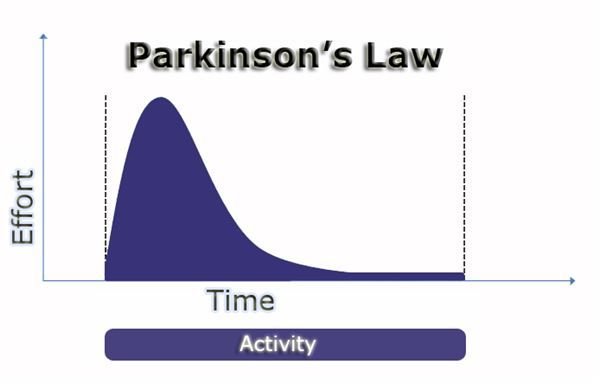Parkinson's Law and Project Scheduling
Introduction
Parkinson’s Law is an adage which was initially postulated by C. N. Parkinson in a humorous context. In its original form, the law states
“Work expands so as to fill the time available for its completion.”
The law was initially postulated by Parkinson based upon his research of the British Civil Service. It was used in the form of a mathematical equation to explain the rate at which bureaucracies expand over time in terms of number of employees and quantum of red tape.
One of the findings from Parkinson’s extensive research was the constant increase in the number of employees in the British Colonial Office year after year, in spite of a significant lack of increase in the amount of work to be done. This meant there were more and more people being recruited for the same amount of work, with each person’s workload, and therefore productivity, decreasing year-on-year.
Applications of Parkinson’s Law in Project Scheduling
From the above historical example, the law appears to be very simple in nature, it is very profound in its meaning, and has a huge impact upon Project Schedules.
Hence a good understanding of Parkinson’s Law is very important for project managers as illustrated below.
Impact upon Project Scheduling:-
- As the time allotted to a task increases, the effort put in by the employees decreases due to complacency. Employees tend to work faster when the deadline comes up and work slower when they have the luxury of long deadlines.
- For critical path activities, delays accumulate and tend to delay the overall project schedules. However, time saved on individual activities does not accumulate, and has no impact on the overall project, because subsequent tasks only start on the start date as per project schedules.
- Employees try to work at a pace within their comfort zone and avoid completing and submitting tasks ahead of project schedules in order to avoid setting (similar) high expectations for future tasks.
- As and when more time gets allotted to a task increases, an employee’s efforts and productivity decreases. However if the time is decreased at a later stage, employees find it difficult to return to their earlier pace of working.
- This phenomenon is frequently seen in IT and software projects especially in the areas of Application Value Management, due to the tendency of the Project Manager to ask for and obtain long deadlines from the clients in order to guarantee delivery.
Safeguard Measures
A project manager needs to be alert to the dangers of Parkinson’s Law and take suitable steps to guard against them.
A few such measures are listed below
- Estimate output per hour for a normal employee. Quantify that as a standard hour of work.
- Measure work and productivity in terms of standard hours of output, not in terms of hours worked.
- Performance linked incentives (PLI’s) should be used. (These have recently become the industry norm.)
- Constantly evaluate employee workloads and provide challenging assignments.
- Goal setting and project timelines should be without a very large margin of comfort. This will push employees to work to their potential and prevent them from becoming complacent.
- Make use of timesheets effectively. Set an example by filling a timesheet in high detail. Monitor and ensure compliance from employees.
- Offer perks and rewards for suggestions to improve productivity. Foster an organizational environment wherein employees constantly look for opportunities to improve.
- Make use of metrics such as Revenue Per Employee, Sales Per Employee, etc. The historical variation of such metrics helps to measure improved performance and poor performance over time.
Modern Day Variations of Parkinson’s Law
Parkinson’s Law in its original form was postulated in 1955. While it still is very relevant in today’s context, it has spawned many off-shoots and variants which best describe certain scenario’s in today’s world.
One such variant, with respect to data and storage space is as follows:
“Data always expands to fill the space available for storage.”
Another variation of this used to refer to software bloat (presence of unnecessary/unwanted features in software). known as Wirth’s Law, is described below.
“Software is getting slower more rapidly than hardware is getting faster.”
Another law sometimes attributed to Parkinson is the impact on an individual’s marginal propensity to save, his rise in spending power, and his chronic inability to save in spite of an increase in income. This is explained in the following summary.
“Expenditures rise in order to meet the increase in income.”. This highlights the need for (or) the importance of budgeting.
Thus a broad generalization of Parkinson’s Law can be as described below.
“The demand upon a resource tends to increase in order to match the availability/supply of that resource.”
